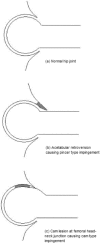The diagnosis and management of femoro-acetabular impingement
- PMID: 20626968
- PMCID: PMC3180305
- DOI: 10.1308/003588410X12699663903791
The diagnosis and management of femoro-acetabular impingement
Abstract
Introduction: Femoro-acetabular impingement (FAI) was first described in 1999 as abnormal abutment between the acetabulum and the femoral head and neck. Since then, it has been shown to be responsible for many acetabular labral tears and is implicated in the aetiology of osteoarthritis of the hip. This review introduces the concept of FAI and reports the key aspects of its diagnosis and management.
Materials and methods: A comprehensive search of the literature was conducted using the Pubmed database. Articles relating to the aetiology, pathophysiology, clinical features, diagnosis and treatment of FAI were reviewed. Search terms included femoro-acetabular impingement, arthroscopic treatment, open treatment, aetiology, pathophysiology. The search was limited to articles published in English. All articles were read in full by the authors and selected for inclusion based on relevance to the article.
Results: An increasing number of studies relating to FAI have been produced in the 10 years since its recognition. A range of clinical and radiological features have been described. Surgical management can be performed using a number of techniques, with promising results from various studies. Early treatment with open surgery has paved the way for less invasive and arthroscopic approaches, with short-to-medium term data demonstrating favourable functional results for arthroscopic treatment of FAI.
Conclusions: A greater awareness of the diagnostic features of FAI, and the various management options available, will allow timely diagnosis and treatment of a relatively newly recognised syndrome. Early treatment may then help to prevent progression to end-stage osteoarthritis of the hip.
Figures

References
-
- Myers SR, Eijer H, Ganz R. Anterior femoroacetabular impingement after periacetabular osteotomy. Clin Orthop. 1999;363:93–9. - PubMed
-
- Ito K, Leunig M, Ganz R. Histopathologic features of the acetabular labrum in femoroacetabular impingement. Clin Orthop. 2004;429:262–71. - PubMed
-
- Ganz R, Parvizi J, Beck M, Leunig M, Nötzli H, Siebenrock KA. Femoroacetabular impingement: a cause for osteoarthritis of the hip. Clin Orthop. 2003;417:112–20. - PubMed
-
- Beck M, Kalhor M, Leunig M, Ganz R. Hip morphology influences the pattern of damage to the acetabular cartilage: femoroacetabular impingement as a cause of early osteoarthritis of the hip. J Bone Joint Surg Br. 2005;87:1012–8. - PubMed
-
- Fraitzl CR, Kafer W, Nelitz M, Reichel H. Radiological evidence of femoroacetabular impingement in mild slipped capital femoral epiphysis. J Bone Joint Surg Br. 2007;89:1592–6. - PubMed
Publication types
MeSH terms
LinkOut - more resources
Full Text Sources

